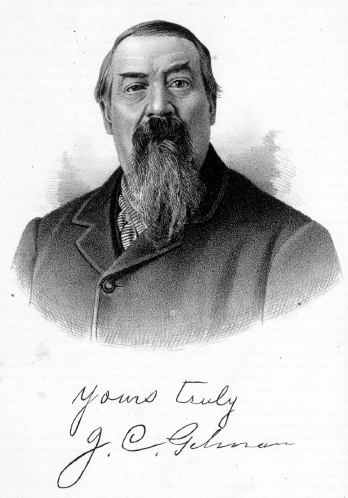together a their present home, and
have labored with the mutual purpose of building up a
comfortable home for themselves and their children,
also securing a good position in their community as
people worthy of the highest respect. Their home and
its surroundings is one of which they have reason to
be proud.

 EREMIAH
C. GILMAN, proprietor of one of the largest farms in
Nebraska City Precinct, is a gentleman well known
throughout this section as one of the old settlers of
this State, coming here as early as 1857. Through a
life of industry and wise economy he has acquired a
competency, and since his return to this locality
twenty years ago, he has built up a comfortable,
commodious home, one of the most attractive in the
precinct. Mr. Gilman comes of sturdy New England
stock, his ancestry being of the hardy, self-reliant,
energetic class that has sent so many brave, resolute
men to conquer and people the Western wildernesses and
prairies. His forefathers were probably early settlers
of New Hampshire, the birthplace of his immediate
ancestry. His paternal great-grandfather, Jonathan
Gilman, was born in 1720, and resided in Carroll
County, N. H.
EREMIAH
C. GILMAN, proprietor of one of the largest farms in
Nebraska City Precinct, is a gentleman well known
throughout this section as one of the old settlers of
this State, coming here as early as 1857. Through a
life of industry and wise economy he has acquired a
competency, and since his return to this locality
twenty years ago, he has built up a comfortable,
commodious home, one of the most attractive in the
precinct. Mr. Gilman comes of sturdy New England
stock, his ancestry being of the hardy, self-reliant,
energetic class that has sent so many brave, resolute
men to conquer and people the Western wildernesses and
prairies. His forefathers were probably early settlers
of New Hampshire, the birthplace of his immediate
ancestry. His paternal great-grandfather, Jonathan
Gilman, was born in 1720, and resided in Carroll
County, N. H.
John Gilman, the grandfather of our
subject, was born Sept. 8, 1749, it is supposed in the
State of New Hampshire, and among her rocky hills and
pastures he passed his life as a farmer, dying at last
in Carroll County. His son Andrew, father of our
subject, first opened his eyes to the light of day
Oct. 5, 1798. on a New Hampshire farm, and after
attaining manhood chose the honorable calling to which
he had been reared, and which had been that of his
forefathers from generation to generation. He married
Dolly Pike, likewise of New Hampshire birth, born in
Coos County, April 5, 1802, and they commenced their
wedded life in the wilds of Coos County, where he had
bought a tract of timber land, which be proceeded to
clear and prepare for cultivation. The country round
about was sparsely inhabited, and for some years
Portland, Me., 100 miles distant, was the nearest
market. Mr. Gilman improved a farm, and there spent
his declining years, dying in 1848. He was a man of
sound common sense, a hard worker, just and kind in
his relations to others, and in his death the
community where he had spent so many useful, busy
years was deprived of a good citizen. His estimable
wife spent her last years with her daughter in Carroll
County, N. H., where she died in 1885. There were six
sons and one daughter born to her and her husband,
namely; Joseph, John K., Fanny E., our subject and his
twin brother Andrew, George and Pike. Jeremiah and his
brother John were the only members of the family who
settled in the West. John died in Nebraska City in
1886.
Jeremiah C. Gilman was born Nov. 8,
1834, at the home of his parents in the beautiful town
of Bartlett, and there amid the grand old hills of his
native State he was nurtured to a vigorous manhood. He
was educated in the district school, and resided on
the old homestead assisting in the farm work until
1854. In that year he and his brother John left the
shadow of the White Mountains to seek a home and
fortune on the broad prairies of the Far West, more
than a thousand miles away. They went by rail to Rock
Island, Ill., then the western terminus of the
railway, and crossing the Mississippi on a ferry boat
to Iowa, took passage on a stage for Ft. Des Moines,
and from there to Greene County, where they identified
themselves with the early settlers. They laid out a
town, which they called Kendrick, and erected a steam
sawmill and a corn cracker, which they operated there
for one year, and then moved it to Warren County,
where they managed it until 1857, then sold it, and in
December of that year came to Nebraska.
Our subject and his brother in
coming to the Territory, located in that part of
Nebraska City called Kearney, and engaged in the
livery business together for two years. Then the
brothers sold out, and again in 1859 started westward,
settling in that part of the Territory now included in
Lincoln County. The whole of that entire section of
the country was wild prairie; deer, antelopes and
buffaloes roamed across it in large numbers, and there
were no settlements nearer than Ft. Kearney. The
brothers went there to start a ranch, raise stock,
and


